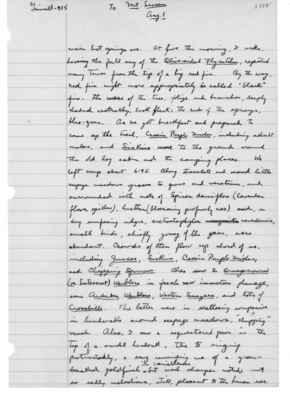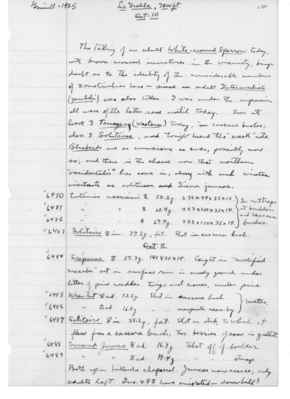Pages That Mention Juncos
1925: Joseph Grinnell's field notes
S2 Page 88
Collector: Grinnell - 1925 Location: To Mt. Lassen Date: Aug. 1 Page Number: 2538 main hot springs are. At five this morning, I woke, hearing the full song of the Olive-sided Flycatcher, repeated many times from the tip of a big red fir. By the way, red firs might more appropriately be called "black" firs: the mass of the tree, folige [sic] and branches, deeply shaded centrally, look black, the ends of the sprays, blue-green. As we got breakfast and prepared to come up the trail, Cassia Purple Finches, including adult males and Siskins came to the ground around the old log cabin and the camping places. We left camp about 6:45. Along streamlets and around little seepage meadows grown to grass and veratrum, and surrounded with mats of Spirea densiflora (lavender flower spikes), heather (blossoming profusely now) and on dry surfacing ridges, arctostaphylos nevadensis, small birds, chiefly young of the year, were abundant. Crowds of them flew up ahead of us, including Juncos, Siskins, Cassia Purple Finches, and Chipping Sparrows. Also saw 2 Orange-crowned (or Lutescent) Warblers in fresh new immature plumage, some Audubon Warblers, Western Tanagers, and lots of Crossbills. The latter were in scattering companies in hemlocks around seepage meadows, "chupping"(?) much. Also, I saw a sequestered pair in the top of a small hemlock. The [male sign] singing protractedly, a song reminding me of a green backed goldfinch in variableness but much sharper noted; not so sadly melodious, still pleasant to the human ear.
S3 Page 38
Collector: Grinnell - 1925 Location: La Grulla, 7200 ft. Date: Oct. 10 Page Number: 2581
The taking of an adult White-crowned Sparrow today, with brown-crowned immatures in the vicinity, brings doubt as to the identity of the considerable numbers of zonotrichias here -- since an adult Intermediate (gambeli) was also taken. I was under the impression all were of the latter race until today. Saw at least 3 Tanagers (Western) today, in cascara bushes; also 3 Solitaires, and tonight heard the "creak" note. Bluebirds are as numerous as ever, possibly more so; and there is the chance now that northern "occidentalis"(?) have come in, along with such winter visitants as solitaires and Sierra juncos. 6480 Eutamias merriami (female sign) 58.2g. 232x99x35x15} in rat traps 6481 Eutamias merriami (female sign) 60.4. 223x100x33x14} at boulders 6482 Eutamias merriami (female sign) 67.4. 228x100x35x14} and cascara bushes. 6483 Solitaire (female sign) im. 37.2g., fat. Shot in Cascara bush. Oct 11 6484 Scapanus (male sign) 37.3g. 141x30x18. Caught in "modified Macabee" set in surface run in sandy ground under litter of pine needles twigs and cones, under pine. 6485 Wren-tit (female sign) ad. 13.5g. Shot in cascara bush} mates 6486 Wren-tit (male sign) ad. 16.0g. Shot in manzanita near-by} 6487 Solitaire (female sign) im. 38.2g, fat. Shot on stub, to which it flew from a cascara bush; two berries of same in gullet. 6488 Townsend Junco (male sign) ad. 16.9g. Shot off of boulder. 6489 Townsend Junco (males sign) ad. 19.4g. Shot off of stump. Both up in hillside chaparral. Juncos now scarce; only adults left. Ims. and (female sign female sign) have emigrated(?) -- down-hill?

